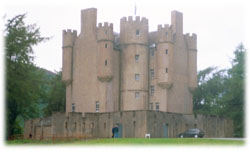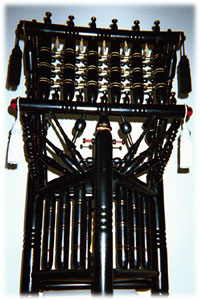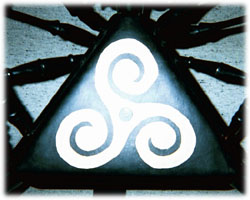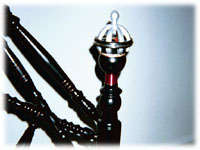 Editor's Note: This article was submitted to the Gathering of the Clans by Erik Findlay, of Copenhagen, Denmark. Erik is an economist and apart from hang-gliding, he enjoys handicrafts such as furniture making in his spare time. Erik is proud of his Scottish heritage, and hopes to go back to Scotland soon for an extended visit. Erik can be reached by email at efindlay@image.dk and he would love to hear from Farquharson Clan members!
What if you have to make something uniformly black and white at the same time? Well I rolled the dice and this is what happened. My line of thinking was "Why only have art on the walls when you can also sit on it?" Picture that if you can but don't practice it with my paintings!
Being of mixed Scottish/Danish descent (from the clan Farquharson on the Scottish side), I traveled to Scotland and visited the 7th century Celtic-shaped Ruinic Ruthwell Cross close to Dumfries. I then proceeded to my ancestral Braemer Castle,
At home I was copying a British 17th century pole chair. This was from inability to find anything particularly Scottish apart from folding tables with spiraling legs, of which I already have one. These chairs are reasonably simple and can be traced back as far as the middle ages, quite common in books of furniture history.
The pole chair is not many generations away from sticking three or four poles in the ground and putting something across to
My decision to make my pole chair was initially based on the originality of its design, but once I connected to The Clan Farquharson on the Internet, I discovered more about my Celtic heritage. I was able to trace half of my family back to Celtic migrations from central Europe to the British isles, and remembered having heard about Gaelic tribes in northern France when I had passed through Galicia in northern Spain on vacation.
That is when I decided to put red Celtic crosses at the bottom end of the backrest for the pole chair, and a Celtic pattern in gold on the seat.
The original pole chair was depicted with something that looked like tower ramparts on the top of the two front poles. I wanted something more spectacular though, and decided to carve out the Farquharson badge in the top right pole: "Fide et Fortitudine" written around a sharp yellow lion wearing a sharp red cape, carrying a sword in its fist and protected inside a silver crown. The top left pole I made into a hollow chamber with an unscrewable top, mainly because I wanted to be able to see the polished shape of a convex surface.
However the thing about it was:
I proceeded by fitting copper threads to the armrests, and finished with imitated gold thread on the backrest, to have the
chair in balance appearance-wise. But I felt that there was something missing from the top of the backrest, where (as
opposed to the bottom) there were no decorative stubs (for lack of better term).
When you sit in the chair you don't cover the top of the backrest (at least not completely), and most people move around
Architects tell you, that if you want to make a nice structure more visible, you should colour it white, because shades augment the basic shape, but I wanted my chair black like the original (and because it fits in with the rest of my furniture). Here I finally re-visit my opening statement, hoping you won't bury me for keeping it under ground so long. "How do you make something black and white at the same time?" The answer I came up with was to polish the chair with wax, so the surface of the wood shines and reflects light, and at that point I thought it was time to stop!
Erik Findlay, November, 1999
|
Thursday, December 26th, 2019
Attention visitors: Tartans.com is back. Please note that this is a snapshot of the site as it existed nearly 20 years ago and you may encounter broken links; we are still combing through the site and correcting those as we find them. Please also note that some sections are currently not functional, primarily the discussion forums/clan chat boards.
|
** HOME - First Time Visitors - Glossary - - Contact Us ** Awards | Bibliography | Clan Calendar | Clan Chat | Clan Finder | History | Famous Scots | Genealogy | Great Hall of the Clans | Links | News and Features | Scots on the Net | Search | Site Map The Gathering of the Clans
Copyright 1995- Tartans.com - All Rights Reserved. |
 residence of my Scottish clan Farquharson, I was told. Was there a connection? Maybe. It was very nice and idyllic, situated some 300 meters above sea level, with highland air, and the river Dee running close by, a picturesque Braemer town and unusual for Scotland: no rain nor wind.
residence of my Scottish clan Farquharson, I was told. Was there a connection? Maybe. It was very nice and idyllic, situated some 300 meters above sea level, with highland air, and the river Dee running close by, a picturesque Braemer town and unusual for Scotland: no rain nor wind.
 sit on the difference of course being the mobility of the pole chair and the turned out ornamentation and differing turned diameter of the poles.
sit on the difference of course being the mobility of the pole chair and the turned out ornamentation and differing turned diameter of the poles.
 black is such a grateful colour when used as background, so I started to put polished copper
threads along the carvings on the bottom of the chair, after having had some fun making the triangular seat.
black is such a grateful colour when used as background, so I started to put polished copper
threads along the carvings on the bottom of the chair, after having had some fun making the triangular seat.
 every once in a while when sitting. I thought I could imitate the effect of a drop crystal in a chandelier by fixing mountain
crystal loosely to the top of the backrest of the chair to shine in light and form movement. Once the braided silver and red
thread bands where added to the balls of the two front poles, things seemed in balance to me that is when to stop?
every once in a while when sitting. I thought I could imitate the effect of a drop crystal in a chandelier by fixing mountain
crystal loosely to the top of the backrest of the chair to shine in light and form movement. Once the braided silver and red
thread bands where added to the balls of the two front poles, things seemed in balance to me that is when to stop?